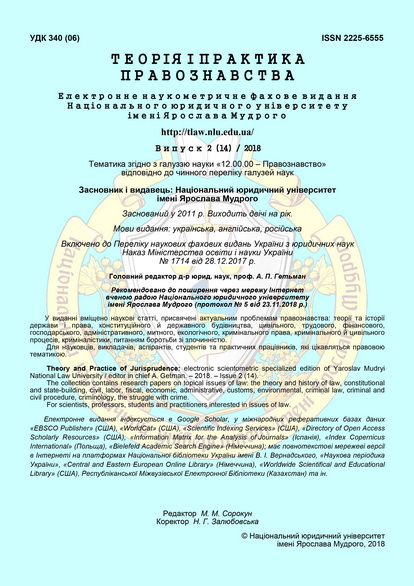Foundations of the self-defense of international intergovernmental organizations
DOI:
https://doi.org/10.21564/2225-6555.2018.14.149269Keywords:
international organization, the right to self-defense, state, armed attack, peacemaking.Abstract
The article is devoted to the study of one of the grounds for exemption from responsibility of international intergovernmental organizations - self-defense. It is provided by Art. 21 Draft articles on the Responsibility of international organizations, adopted by the UN International Law Commission in 2011. The wording of the norm significantly differs from the relevant provision providing a similar right to sovereign states. In particular, it states that “The wrongfulness of an act of an international organization is precluded if and to the extent that the act constitutes a lawful measure of self-defence under international law”. It does not have a direct reference to the United Nations Charter, which is contained in Art. 21 Draft Articles on the Responsibility of the States in 2001. Currently there are no international agreements that envisage the right to self-defense of international organizations. Consequently, the basis for its application can be only an international law custom. Defining it is a complex scientific issue.
Present analysis is based on the legal nature of international organizations. It is pointed out that, unlike sovereign states, they do not have their own territory, which in the vast majority of cases is the main purpose of military attacks by aggressor countries. Consequently, the grounds for applying the right to self-defense of international organizations are quite limited. They are mainly related to the negative circumstances in which police and peacekeeping units operate acting on the mandate of the relevant international organization and on its behalf. In other cases, international organizations are protected by agreements with the states on its territory their headquarters are located, where the guarantees of their safety and integrity are expressly provided. It is pointed out that it is highly likely that some of new means of direct and indirect intervention that are already being used to interfere in internal and external affairs of states will probably be applied to international organizations in the future.
References
Bolee bozopasnyi mir: nasha obshchaia otvetstvennost`: Doklad Gruppy vysokogo urovnia po ugrozam, vyzovam i peremenam (A more secure world: our shared responsibility Report of the High-level Panel on Threats, Challenges and Change) (A/59/565) ot 2 decabria 2004 goda. 59 sessia General`noi Assamblei OON. Punkt 55 povestki dnia: Posleduyushchiie mery po itogam Sammita tysyacheletiia. URL: https://undocs.org/ru/A/59/565 (in Russian)
Doklad Komissii mezhdunarodnogo prava. 66 sessiia (26 aprelia – 3 iyunia i 4 iyul`ia – 12 avgusta 2011 goda). General`naia Assambleia OON. Oficial`nyie otchoty. 66 sessia. Dopolneniie # 10 (A/66/10). OON,New York, 2001 (in Russian)
Zajemskii, V.F. (2008). OON i mirotvorchestvo (UN and Peacemaking).Moscow: Mezhdunar. Otnosheniya (in Russian).
Lukashuk, I.I. (2004). Pravo mezhdunarodnoi otvetstvennosti (Law of international responsibility).Moscow: Mezhdunar. Otnosheniya (in Russian)
Mutagirov, D.Z. (2013). Pravo cheloveka na soprotivlenie: jego ponimaniie v proshlom i nastoiashchem. Vestnik S.-Pb. Gos. Univ. Ser. 6, issue 1, 67–78 (in Russian).
Nguen Quok Din`, Daie P., Pele A. (2000). Mezhdunarodnoie publichnoiei parvo. (Vols 1–2); Vol. 1, book 1: Formirovaniie Mezhdunarodnogo prava, book 2: Mexhdundrodnoije soobshchestvo.Kiev: Sfera (in Russian).
Rezoliutsia General`noi Assamblei OON 3314 (XXIX) “Opredelenie agressii” ot 14 dekabria 1974 goda. URL: http://www.un.org/ru/documents/decl_conv/conventions/aggression.
Rzhevs`ka, V.S. (2005). Pravo derzhavy na samooboronu i mizhnaridna bezpeka: monografia / KNU im. Shevchenka T., Instytut mizhnarodnyh vidnosyn. Kyiv (in Ukrainian).
Sivash, O.M. (2017). Samooborona iak obstavyna, shcho vykljuchaije protypravnist` diyannia. Jievroatlantuchna integratsiia Ukrainy: svidimui vybir modeli bezpeky: zb. nauk. st. za materialamy III Khark. Mizhnarod.-pr. Chutan` pam`iati prof. M.V. Yanovs`kogo i V.S. Semenova (Kharkiv, 3 lystop. . 2017 r.): in 2 parts. A.P. Getman, I.V. Yakoviuk, V.O. Samoshchenko (Eds.). Kharkiv, part. 1, 108–115 (in Ukrainian)
Soglashenije mezhdu OON i pravitel`stvom S.SH.A. otnositel`no mestoraspolozheniia Tsentral`nyh uchrezhdenii OON1947 g. URL: http://www.un.org/ru/documents/decl_conv /conventions/headquar.shtml.
Soglashenije o Shtab-Kvartire Sekretariata Dogovora ob Antarktike2010 g. URL: https://ats.aq/documents/keydocs/vol_1/vol1_15_Secretariat_Headquarters_Agreement_r.pdf.
Soglashenije o pravovom statuse Organizatsii dogovora o kollektivnoi bezopasnosti 2002 g. URL: http://www.odkb-csto.org/documents/detail.php?ELEMENT_ID=125.
Azubuike, E.C. Probing the Scope of Self Defense in International Law. Annual Survey of International & Comparative Law. Vol. 17, Issue 1. P. 129–183.
Bakircioglu, O. The Right to Self-Defence in National and International Law: the Role of the Imminence Requirement. Indian International & comparative Law Review. Vol. 19. 2009. No. 1. P. 1–48.
Case Concerning Military and Paramilitary Activities in and against Nicaragua (Nicaragua v. United States of America), Judgment of 27 June 1986. I.C.J. Reports. 1986.
Findley, T. The Use of Force in UN Peace Operations.USA, NY,OxfordUniversityPress, 2002.
Möldner, M. Responsibility of International Organizations – Introducing the ILC’s DARIO. Max Planck Yearbook of United Nations Law. 2012, Vol. 16. P. 281–328.
Mrázek, J. The Right to Use Force in Self-Defence. Ćzech Yearbook of Public & Private International Law. 2011. V. 2. P. 33–56.
Special Agreement relating to the Seat of the Council of Europe Paris, 2.IX.1949. URL: https://rm.coe.int/168006373b.
Downloads
Published
How to Cite
Issue
Section
License
Copyright (c) 2018 Theory and practice of jurisprudence

This work is licensed under a Creative Commons Attribution 4.0 International License.




